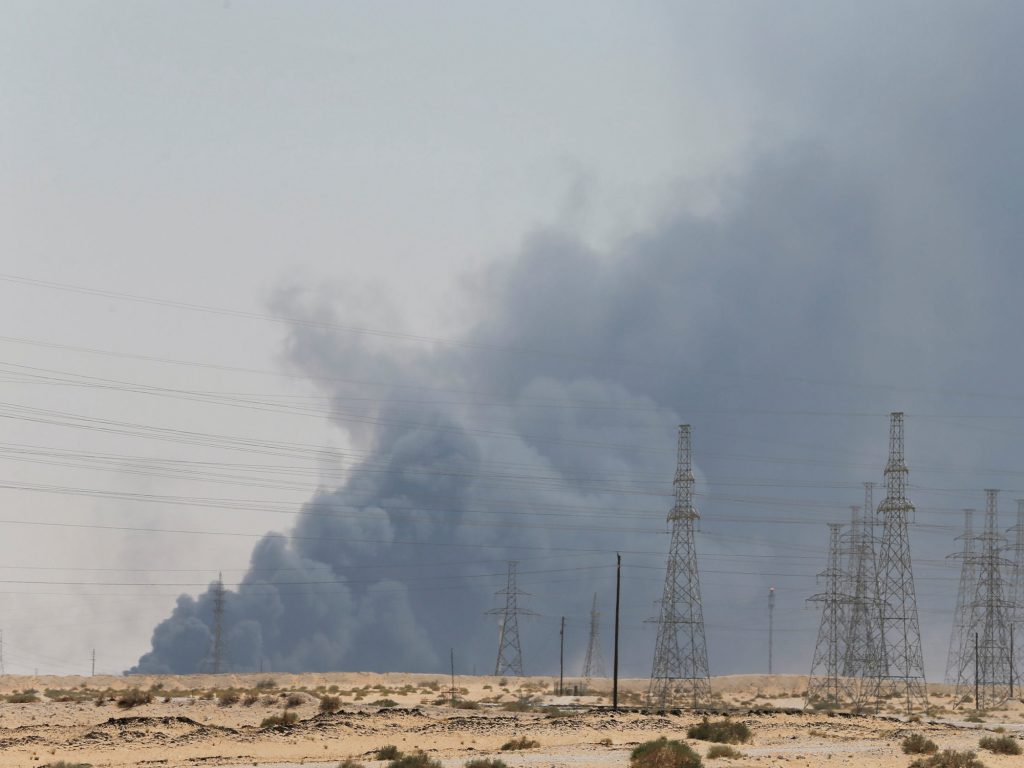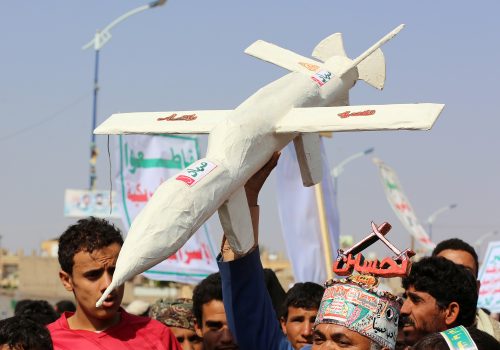Major Saudi Arabian oil facilities were attacked in a series of drone strikes on September 14, endangering the supply chain of the world’s largest oil producer and further escalating tensions in a region already on edge.
Ten drones hit oil facilities of the state-owned oil giant Saudi Aramco on September 14—including a massive facility in Abqaiq—in a series of attacks which Houthi rebels in Yemen have claimed responsibility for. Houthi rebels have been fighting Yemen’s government—supported by Saudi Arabia and other Gulf allies—since 2015.
Despite the Houthis’ claims, US Secretary of State Mike Pompeo pointed the finger at Iran, tweeting that “Iran has now launched an unprecedented attack on the world’s energy supply. There is no evidence the attacks came from Yemen.” Tensions between Iran and the United States and its allies have worsened over the last few months following Tehran’s June announcement that it had stopped complying with the 2015 nuclear deal—known as the Joint Comprehensive Plan of Action (JCPOA).
On June 12, two commercial tankers were damaged in the Strait of Hormuz and a US drone was shot down on June 20, both attacks Washington blamed on Tehran. In July, the US navy announced it had shot down an Iranian drone that made an aggressive action against a US vessel, and on July 19 Iranian forces seized a British oil tanker in retaliation for the detention of an Iranian tanker in Gibraltar.
Responding to the latest attack, US President Donald J. Trump tweeted on September 15 that “there is reason to believe that we know the culprit, are locked and loaded depending on verification, but are waiting to hear from the Kingdom [of Saudi Arabia] as to who they believe was the cause of this attack, and under what terms we would proceed!”
Reports suggest that the attack disrupted more than half of Saudi Arabia’s oil capacity, making up 5 percent of the total global daily supply of oil. Before the open of business on September 16, US oil futures reached $60 a barrel—a jump of about 10 percent. The increase in price was slightly muted by Trump’s announcement on September 15 that the United States would release supplies from its Strategic Petroleum Reserve (SPR) to try to contain prices.
The attack on the Saudi Aramco infrastructure comes just a week after Prince Abdulaziz bin Salman bin Abdulaziz al-Saud replaced Khalid al-Falih as the energy minister of Saudi Arabia. The move was seen as a potential sign that Riyadh was pushing for an initial public offering (IPO) for the state-owned oil company in order to raise more funds for overall diversification of the Saudi economy.
Atlantic Council experts react to the attacks on Saudi oil infrastructure and what they mean for global energy markets:
Randolph Bell, director of the Atlantic Council’s Global Energy Center:
“The strikes on Aramco’s key oil processing facilities follow two dramatic weeks of energy leadership reshuffling in the Kingdom and statements that the Crown Prince’s intention to IPO a portion of Aramco soon. While it is not yet clear if the attacks were from missiles, drones, or both, and if they were launched by Iran-backed Houthis from Yemen, Iranian proxies in Iraq, or from Iran itself, they are surely a significant escalation from recent clashes in the region.
“Given the timing and the escalation, the strikes should be seen not just as an attack on Saudi’s oil infrastructure, but on the IPO itself and MBS’s broader economic agenda for the Kingdom.
“It remains to be seen how long it will take Aramco to resume full operations. After initial reports that the facilities will be back online by September 16, Aramco officials stated on September 15 that they should get about one-third of production by September 16 and will update on the remainder on September 17.
“Though there is plenty of oil in storage at the moment and President Trump authorized release of the Strategic Petroleum Reserve if necessary to keep prices in check, a longer timeline for the repair of the facilities would still have serious implications for the global oil market. It would also underscore Aramco’s vulnerability to regional instability at a time when it is looking to attract outside investment.
“But even if the interruption is relatively short, which is more likely, and Saudi benefits from the jump in the price of oil—which, under other circumstances, would raise Aramco’s IPO valuation—the attacks are still far more likely to remind investors of the geopolitical risk the company faces and ultimately hurt the IPO. This particularly true if tensions continue to ratchet upwards in the region, as President Trump suggested on September 15.
“In short, the attacks should signal to MBS that if he wants to modernize and diversify the Kingdom’s economy on the back of Aramco’s wealth, the Iranians will try to have a say in the matter.”
Read more on the tensions between the US and Iran:
Kirsten Fontenrose, director of Regional Security in the Atlantic Council’s Middle East Programs:
“During Prince Khalid bin Salman’s recent meetings with senior leaders at the State and Defense Departments and the Central Intelligence Agency, he was clear that while Saudi Arabia supports economically squeezing the Iranian regime, they do not wish to see a war with Iran. While the context has changed in light of the weekend attack on Abqaiq, the reasons have not. Saudi Arabia would find itself on the front line of an armed conflict, with Iran or its proxies to the east, south, and north. Such a conflict would also cripple plans for an Aramco IPO and would drive foreign investment from the country. Saudi Arabia has many long term reasons to showcase its resilience and de-escalate.
“The challenge for the US administration is proving the origin of the drones without revealing sources and methods. Unless a few critical details can be declassified, the world will have to take the administration at its word. We learned when [Syrian President Bashar] al-Assad used chemical weapons in Douma in April 2018—but much of the world refused to believe it—that this can be a hard sell.”
Read Fontenrose’s full blog:
Phillip Cornell, nonresident senior fellow in the Atlantic Council’s Global Energy Center:
“Abqaiq is indeed a critical facility in the Saudi oil processing chain, where more than half of the country’s crude oil is stabilized for safer transport further downstream. The facility has been a known critical infrastructure in the global oil market for a long time, and has been targeted for attack in the past, notably in 2006. It is also the site of a major Aramco residential camp, which also serves as an overflow for Aramco corporate headquarters staff, as well as some drilling and refining operations.
“There is still some uncertainty about what hit the facility, but initial damage imagery from the site indicates seventeen points of impact, each individually targeted to specific buildings including stabilization centers. Whether drones or missiles, these attacks appear both asymmetric (hard to trace) and accurate.
“The large immediate impact on production is partly a result of evacuations and personnel safety. Fires have been extinguished, and much of the lost processing throughput should be online by September 16. Further repairs could be completed in a matter of weeks. Saudi oil stocks can make up for the shortfall, so export deliveries should not be affected, and strategic stock releases by the International Energy Agency or the US SPR are probably unnecessary.
“However, the attacks highlight the vulnerability of Saudi infrastructure to cheap, accurate, and long-range attacks and more generally to geopolitical events. In an oil market that faces structural softness from weaker demand, surging unconventional supply, and long-term displacement, geopolitical risk may buoy prices just as regional producers are struggling to leverage them. But a heightened risk premium is likely to dampen interest in Aramco stock ahead of an IPO, and if the forward curve shifts up it could also encourage more North American drilling, further squeezing the Saudi fiscal position just as it seeks to invest in economic transition.
“What is more troubling is the systematic dismantling of institutions and commitments meant to underpin stable oil markets. The SPR is designed as an insurance against such outages, and the Trump government is overseeing further sell-offs. US commitment to regional security has always been key, and current policy is erratic. The divisive approach to Iran means that traditional US allies are not on-board. Geopolitics and great-power competition are playing a greater role in economic policy these days, and while that may satisfy some narrow interests, it does not bode well for stable energy prices, or for the secure and dependable delivery of energy along global supply chains.”
Ellen Wald, nonresident senior fellow in the Atlantic Council’s Global Energy Center:
“Aramco runs its company very professionally and has a great deal of redundancy and built in storage. The company always touts its ability to provide its customers with 99 percent reliability. Aramco has been prepared for this kind of damage and, in fact, has dealt with series damage several times in its history. These attacks represent an event, not a fundamental change in the supply of oil.
“Perhaps the most important and lasting consequences of the attack on Abqaiq and Khurais will not be felt in the market moves this week and next, but on the effect this will have on Saudi Arabia’s OPEC policy in 2020 and even into 2021. Saudi Arabia has been drawing on stored oil for months to satisfy customer demand while keeping its output below its OPEC+ quota. Now, Aramco will be drawing from storage at an even greater rate to make sure all customer orders are fulfilled until full capacity is restored.
“Aramco will need to pump even more oil to refill its storage for a long time to come, especially if Saudi Arabia does not intend to pump over its OPEC+ quota. Refilling stored oil is seen as a strategic necessity and as a result, Saudi Arabia will be unlikely to support further production cuts. As for the Aramco IPO, at present, Saudi Arabia appears focused on foreign policy calculations and not on assuring potential equity investors of Aramco’s ability to recover and resilience in the face of such threats. This could be an issue if Saudi Arabia pursues plans for an Aramco IPO on Tadawul in 2019 or early 2020.”
Jean-Francois Seznec, nonresident senior fellow in the Atlantic Council’s Global Energy Center:
“The drone attacks on the Abqaiq oil processing complex is a major escalation in the proxy war between Saudi Arabia and Iran. Abqaiq treats and prepares for export the oil from the very rich Saudi oil fields of Ghawar, Shaibah, and others. The processing complex is heavily protected from ground attacks and had repelled al-Qaeda actions in the past. However, air attacks, which should have been prevented by the Patriot missiles, have worked. The sophistication of the drones and of the attack itself will, of course, be interpreted as Iran being responsible for the attack.
“Until now, Iran and Saudi Arabia were protected by the fear of mutual destruction of their main oil export assets, should one attack the other’s facilities. Now that the Iranians have lost most of their export capacity due to the US sanctions, this fear of mutual destruction is no longer there. The Iranian leadership may feel they have little to lose by attacking the exports of Saudi Arabia.
“The question is not whether the Saudis will retaliate but when, how, and with how much support from the United States. Furthermore, the Russians will be great beneficiaries as they will earn much more per barrel on their oil and gas exports. Of course, the United States, now the largest exporter in the world, will also benefit greatly. Even, with a price that could easily double, the Saudi remaining exports will still earn amounts close to what they earned before. Only China, who imports most of its crude from the Gulf, will be financially hit at the tune of $1.1 billion for each dollar increase per barrel.
“Thus, except for China, few of the players will seek to defuse the situation, all feeling that they have little to lose and much to gain. Hence, it would seem that the September 14 attack stands a strong chance of escalating into an all-out conflict.”
Reed Blakemore, associate director in the Atlantic Council’s Global Energy Center:
“For the past several months, the market has been devaluing a building portfolio of geopolitical risks in favor of the demand-side impact of strong economic headwinds. The events of September 14 change that, and the 5 million barrels per day now estimated to come offline has momentarily forced the geopolitical risk premium back into to the market.
“Looking ahead, several questions are worth considering, the first being one of supply. Riyadh has announced that about 50 percent of the now-offline production could brought back to market within the next few days. The rest, particularly the damaged units reportedly responsible for processing Saudi’s heavy crudes, could take much longer.
“Moreover, the severity of this attack brings renewed clarity to the depth of tensions between the United States, Saudi Arabia, and Iran. Whether or not this was an attack directly orchestrated by Iran or facilitated with Yemeni-based Houthi rebels as their agents, Iran has signaled its ability to strike this infrastructure and expanded the playing field of supply risks not just to possible closures in the Strait of Hormuz, but oil production itself from a number of possible vectors. How Washington and Riyadh choose to respond (for now limited to rhetoric) will show exactly whether this is a flash in the pan or a step-change in Gulf tensions.
“Both elements will have an impact on question two, how a new geopolitical ‘Gulf premium’ will be priced into the market. A quick return of Saudi production will make prices bounce, but likely be steadily absorbed by a still-gloomy demand outlook and keep the market in backwardation. A more prolonged outage will bake a ‘Gulf premium’ into oil prices over the long term and possibly push the forward curve into contango should the crisis continue to deepen.”
David A. Wemer is associate director, editorial at the Atlantic Council. Follow him on Twitter @DavidAWemer.
Contact an AC expert
Image: Smoke is seen following a fire at an Aramco factory in Abqaiq, Saudi Arabia, September 14, 2019. REUTERS/Stringer












